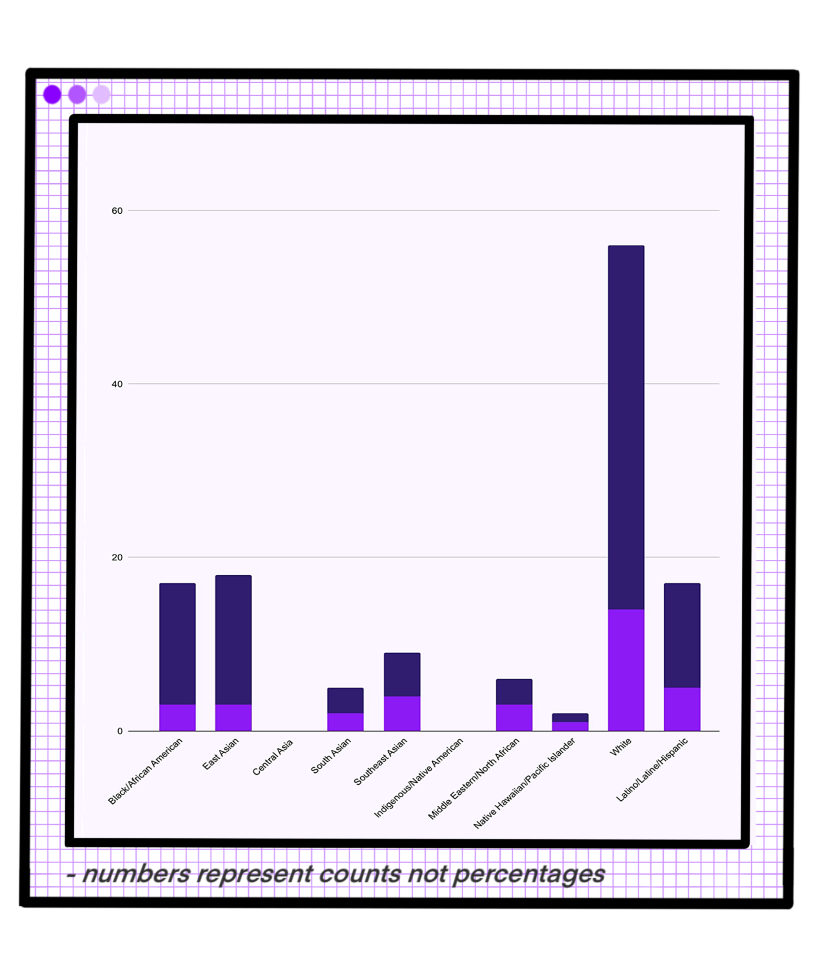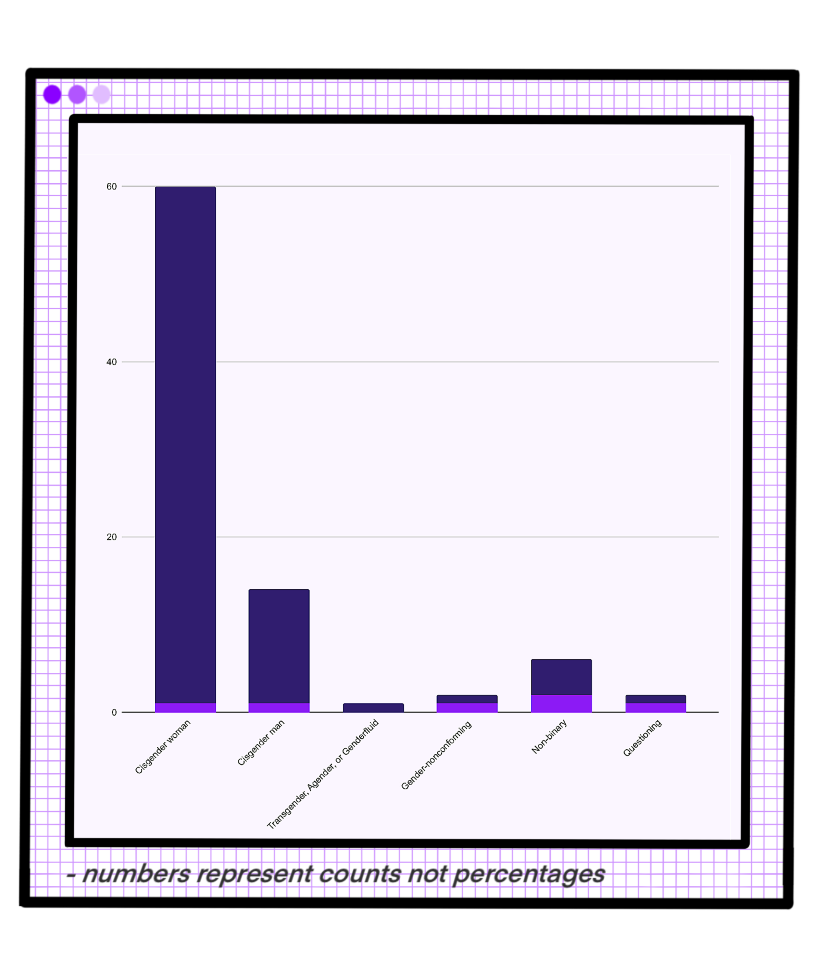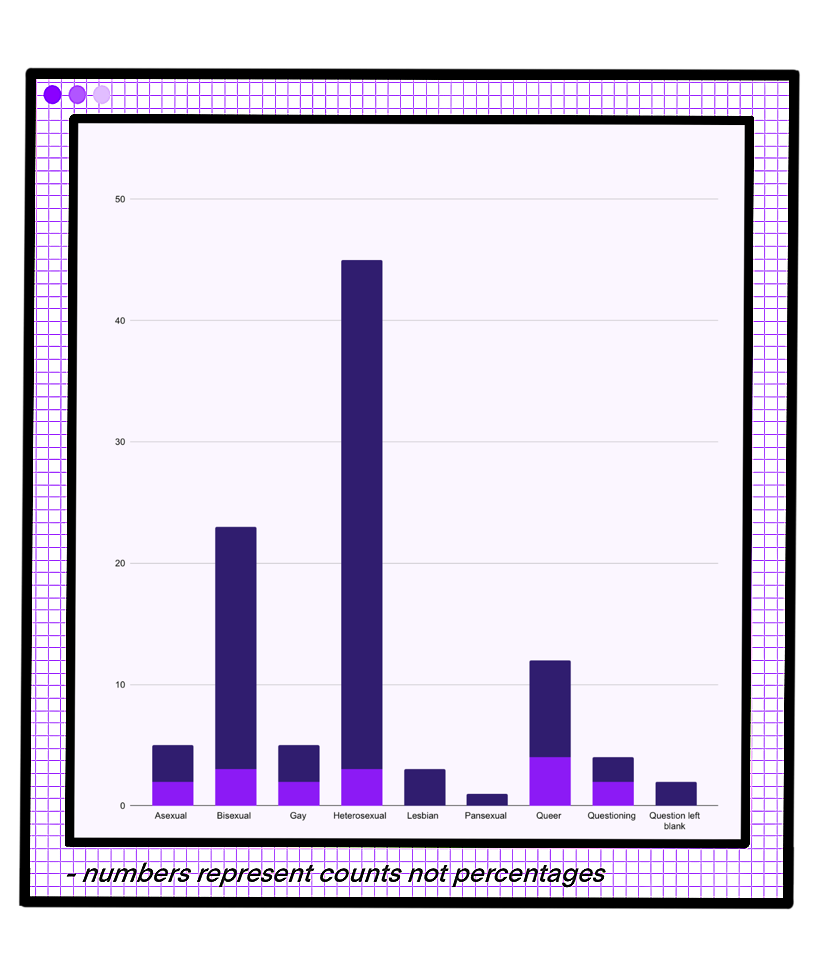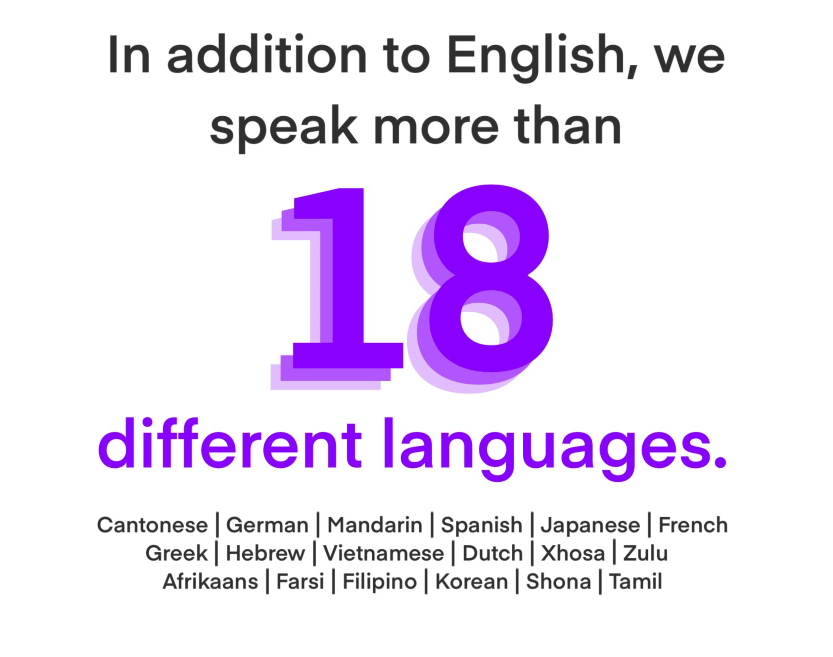North by Northwestern (NBN) has been publishing a report every quarter for two years that shows the demographics of our staff and contributors. The purpose of this report is to be transparent and accountable within the newsroom and to inspire other newsrooms to do the same. This report is typically released in the first half of the following quarter after data is collected from surveys filled out by staff.
In past reports the number of respondents has been decreasing each quarter, with a particularly low response rate this past Spring. Our Fall survey had a total of 76 responses, which was greater than past quarters and can be attributed to a new influx in writers and editors consistent with the beginning of the school year.
For this report, we do not distinguish between web and print staff. In the Fall, 67.1% of the respondents were either part of the editorial staff or contributors to the web team, and 44.7% of respondents belonged to the print editorial/creative or contributing teams, with 3.9% belonging to our the corporate team.
Race & ethnicity

The majority of NBN staff identified as white, as in previous quarters. NBN does not include an option in our survey for identifying with two or more races; instead, we allow staffers to check boxes for all races and/or ethnicities they identify with. The number of respondents who only identify as white decreased from 44.8% in the Spring to 36.8% in the Fall. The percentage of staff who identify as white and another race dropped from 19% to 18.4%. Of the respondents, four identified as Latinx / Latine / Hispanic and white.
The percentage of staffers identifying as Latinx / Latine / Hispanic decreased from 19% to 15.8%, but the number of responses increased from 11 to 12. This change in percentage can be attributed to an increase of staff at NBN.
The number of Asian and/or Asian American respondents increased from 27.6% in the Spring to 30.2% in the Fall. NBN asked Asian and/or Asian American students to provide subgroup identifications to reflect the diversity of the Asian diaspora. East Asians remain the majority out of all the Asian and/or Asian American respondents from our staff, with the number increasing from 11 to 15 in the Fall. The number of South Asian respondents increased to three, and Southeast Asian respondents increased from four to five. With this increase, East Asians make up 65.2% of all Asian and/or Asian American staff and contributors at NBN, down from 68.8% in the Spring.
The number of Black / African American staffers at NBN increased from three to 14 — making up 18.4% of our staff this past quarter. We are still falling short in our representation of Middle Eastern / North African, Indigenous / Native American students and Native Hawaiian/Pacific Islander, with less than 5.3% of staffers identifying with these races and ethnicities.
According to data from the University for the 2021-22 school year, the total undergraduate population at Northwestern is 39.3% white, 20.4% Asian, 13.9% Latino/Hispanic, 6.1% Black and/or African American and 6.7% two or more races. The data also indicated that among the undergraduate population, there are only six American Indian or Alaska Native students and only one Native Hawaiian or other Pacific Islander student, although anecdotal evidence from NBN staffers suggests these numbers may be underreported. The data did not record the overlapping identities of students who identified as Latino/Hispanic or who identified as more than one non-Hispanic race, which makes direct comparison difficult.
Based on Northwestern's data, NBN’s newsroom over represents Asian and/or Asian American, Latinx / Latine / Hispanic students and Black / African American students compared to the overall undergraduate population at NU, and underrepresents white students. NBN allows its staffers to select as many races and ethnicities as apply to them, which may elevate percentages across the board compared to official University data.
Gender identity

The major and minor breakdowns of the data we collected from the Fall 2022 survey remained similar to the Spring. Gender identity is fluid, and to reflect that, our survey allowed staffers to select multiple identities for their gender.
As with previous quarters, our newsroom continues to be mostly made up of staffers who identify as cisgender women. The percentage of our staffers who identify as cisgender women rose from 74.1% in the Spring to 77.6% in the Fall. Meanwhile, the percentage of staffers who identify as cisgender men fell slightly from 17.2% in the Spring to 17.1% in the Fall.
The percentage of staff who identify with a gender outside the gender binary also fell. Our survey provided the following options to staffers who identify outside the gender binary: agender, genderfluid, gender-nonconforming and non-binary. Of our staffers, 7.9% identify outside the binary; within that percentage, 2.6% identify as transgender or gender-nonconforming, and 5.3% identify as non-binary. Since our Spring 2021 survey, we have separated the cisgender and transgender options in order to more accurately identify the variety of gender identities within our newsroom. Additionally, our survey provides staffers the option to identify as questioning as we recognize that gender discovery is a process in which everyone is at a different stage.
In the context of Northwestern’s undergraduate student population, cisgender women remain overrepresented within the NBN newsroom. According to the University’s data from the 2021 - 2022 school year, 53.2% of undergraduate students are women while 46.8% are men. However, the University’s data does not include the statistics for students who identify outside of the gender binary and does not report the variety of genders within the student body. These statistics were the best metric we could find to compare our own survey results with.
Sexuality

In the Fall, 55.3% of the staff and contributors at NBN identified as heterosexual, which is slightly higher than 52.6% in the past Spring. Some staffers selected more than one sexuality, so the total percentages may add up to more than 100%.
Bisexuality continues to be the second-most represented sexuality at NBN, with 26.3% identifying as bisexual, almost double more than the 15.8% who identified as bisexual in the Spring. The percentage of respondents who identify as queer stayed the same, with 10.5% respondents in the Fall and 10.5% in the Spring. The percentage of staff identified as lesbian also dropped from 7% to 3.9%. Additionally, the 10.5% of respondents who identified as gay this past Spring dropped to 3.9%, and the amount of staff identifying as questioning dropped from 6.9% to less than three percent. According to a 2022 study by Gallup, around 20.8% of Gen Z adults identify as LGBTQ+.
Language

Members of NBN staff this past Fall spoke a combined total of 15 different languages other than English. About 19.7% of our staff speaks Spanish, and 11.8% of our staff speaks Mandarin, down from 31% and 15.5% respectively in the Spring; however, our Fall survey recorded 18 more responses than the Spring version. French remains the third most-spoken language, with four speakers on staff. NBN staff members also spoke Cantonese, Farsi, Filipino, German, Hebrew, Japanese, Korean, Mandarin, Shona, Vietnamese, Greek, Dutch, Xhosa, Zulu and Afrikaans. In total, 40.8% of our staff spoke a language other than English.
International students
The percentage of international students among our staff increased from 3.4% in the Spring to 5.3% in the Fall. Despite this increase, international students remain underrepresented in NBN. The number of international students at NBN has continuously decreased since it was first recorded in the Spring 2021 survey, when international students made up 10.4% of our staff. According to the University’s 2021-2022 data, international students are 10.2% of Northwestern’s undergraduate student population.
Socio-economic status
First generation students made up roughly 10.5% of our newsroom staff last Fall, an increase from 6.8% who were on staff in the Spring. First generation students continue to be underrepresented in NBN’s newsroom, as according to a report by Northwestern, 15% of the class of 2026 and 13.2% of the class of 2024 are first generation.
In the Fall survey, 18.4% of staffers identified as low income, an increase from the previous two quarters, with 12.7% in the Winter and 8.6% in the Spring. NBN also asked students about their employment status to see how staffers may have to balance their work in the newsroom with other jobs or commitments. About 63.2% of students reported having a form of employment outside the newsroom, a slight increase from 62.1% in Spring.
In addition, NBN continued to ask students whether or not they receive financial aid from Northwestern, in an effort to have a more empathetic understanding of their socio-economic background. About 52% of staff said they received some form of financial aid, an increase from the Spring when 49.1% reported receiving financial aid. According to Northwestern, 61% of undergraduate students receive financial aid.
Religion
Once again, in the Fall the largest group of staff members identified as Christian, with 22 respondents compared to 14 in the Spring. The second-largest group was those who identified as Agnostic, which increased from 12 respondents in Spring to 20 people in the Fall. 11 staff members identified as Jewish, which is slightly lower than the 12 who identified as Jewish in the Spring. Another 11 staff members identified as Atheist. In the Fall, 11 staff members identified as spiritual but not religious. Other religious affiliations reported by staff members include Hindu, not practicing, none or nondenominational.
Disability
The percentage of staffers with disabilities has risen from 17.2% in Spring to 18.7% in the Fall. This percentage is greater than that of Northwestern undergraduates registered with AccessibleNU. According to Northwestern’s most recent diversity, equity and inclusion report, 12.3% of the undergraduate population is registered with AccessibleNU. However, NBN is aware that not all students with disabilities are registered with AccessibleNU; we use the university’s report as the best metric available to compare our survey results with. A few respondents chose to elaborate on their disabilities, but we are choosing to keep their responses unpublished to respect the privacy of our staff.
Takeaways
In the Fall, NBN began expanding our resources and experimenting with new ways to maintain accountability as a publication and promote conversations surrounding diversity, equity and inclusion in our newsroom. For the first time, Medill’s DEI director Robert Brown facilitated our quarterly DEI dialogue, which we held in the early weeks of Fall Quarter in order to forefront DEI conversations in our publication. The Fall also saw the re-emergence of our DEI editor position, with our new editor overseeing the content of the publication, adding to our DEI style guide and engaging in conversations with writers and editors covering sensitive topics on both the web and magazine sides of NBN. We also launched an anonymous reporting form linked on our social media platforms for readers and NBN staffers alike to report concerns about our coverage or culture in the newsroom.
In our mission to continue promoting transparency, NBN’s leadership team decided to begin tracking the demographics of our sources in Fall Quarter. However, our source tracking methods fell short of giving us an accurate depiction of source representation in our coverage. We asked sources to fill out a completely anonymous form that would collect their demographic information in an effort for NBN to identify what students voices were most prevalent and which were missing from our reporting. Due to miscommunications with sending out the form, our staff did not collect many responses from interviewees. Starting this Winter, NBN editors will be requiring writers to send our post-interview, source tracking form to every student they interview. We feel that having writers involved will encourage the students they have spoken with to participate in our source tracking efforts. The form will remain optional for those who would prefer not to have their demographic information recorded by NBN. We hope to be able to publish the results of that data in our Winter 2023 report.
We had also hoped in the Fall to launch our affinity spaces for different minority groups within NBN, but we were unable to coordinate with affinity organizations on campus to plan those spaces in a timely manner. As the percentage of our staff who hold underrepresented identities in journalism continue to grow, we hope this Winter to finally establish those spaces in conjunction with affinity groups on campus, including NAHJ, NABJ and AAJA. We are expanding our DEI editor position to include three editors who will be focusing on facilitating conversations in our newsroom surrounding DEI, organizing our DEI dialogue, coordinating our diversity survey and creating these affinity spaces for NBN writers and editors. We also invited Medill DEI director Robert Brown back to NBN to host our DEI Dialogue in the Winter.
Most importantly, it is a central tenant in NBN that the promotion and consideration of diversity, equity and inclusion is the responsibility of every one of our writers and editors. While NBN is excited about the growing diversity in our newsroom and in our coverage, it is necessary for our staff to continue creating space for DEI conversations and considerations that will make our newsroom a safe and welcoming safe for writers and editors of all backgrounds, and make our coverage as fair and inclusive as possible.
Data graphics designed by Olivia Abeyta.